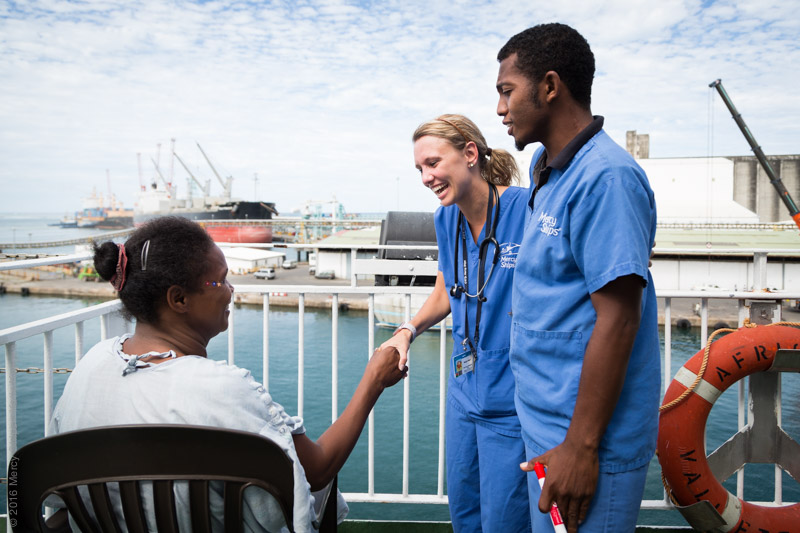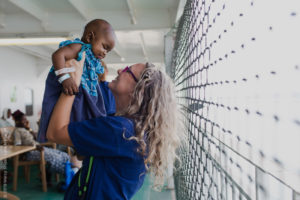When nurses think about volunteering, they may imagine doing so somewhere in their own backyard. While all type of volunteering to help others is important and valuable, there are many different types—some may even take you across the world. Meggin Tallman RN, BSN, now a Pediatric Critical Care Nurse at Children’s Hospital of Alabama, has volunteered a number of times with Mercy Ships. She wants to spread the word about this amazing organization, so she answered our questions.
What is Mercy Ships?

Mercy Ships volunteer Nurse Meggin Tallman plays the Ukelele with a patient onboard the Africa Mercy.
Mercy Ships is an international faith-based organization bringing hope and healing to the world’s forgotten poor. As many as 5 billion people lack access to safe, affordable surgical and anesthesia services worldwide, and less than 6% of all operations are delivered to the world’s poorest countries. Marginalized populations continue to suffer due to a lack of trained health care providers, inadequate infrastructure, and disproportionate out-of-pocket healthcare costs.
Mercy Ships programs offer holistic support to developing nations striving to make health care accessible for all. Since 1978, Mercy Ships has delivered services to more than 2.56 million direct beneficiaries. Mercy Ships owns and operates the Africa Mercy which is the world’s largest non-governmental hospital ship and is dedicated to the continent of Africa. Mercy Ships has an average of 1,000 volunteer crew, from up to 40 nations, serving onboard the Africa Mercy each year.
How did you get involved with Mercy Ships? Why did you decide to volunteer?
I had always had a dream to serve in developing countries upon completion of my nursing degree. I just really have a service heart, and I feel that I now have a set of skills that are desperately needed all over the world. If I am called to help and have the ability to, then how could I not volunteer?
As a new graduate, I got the opportunity to serve with the hospital I worked for, for a month in Zambia. Following that trip, I knew this was something I was uniquely called to do. When I got home, I really jumped into researching organizations doing medical missions on the continent of Africa, and when I discovered Mercy Ships, my mind was blown that they could do all the things that they do and help the amount of people they do. I instantly applied.
How long were you a volunteer? How did you get time off work?
My first service on the Africa Mercy was in Madagascar for just under four months and the second was just under three months in Cameroon. Those trips were somewhat easier to manage as I was a travel nurse at the time and could plan trips in between contracts. This last service with Mercy Ships was for six weeks in Guinea, and I, thankfully, have a boss who has a heart for missions as well. We were able to work together to help me take a leave of absence so I could fill a critical need the ship had for a pediatric ICU nurse.
What did you do with Mercy Ships? How many people did you help (estimate)?
On board the Africa Mercy I worked in D ward, which is the maxilla-facial ward, and my role was a pediatric ICU nurse. That being said, I treated kids and adults alike with ailments ranging from large tumors of the face and neck to cleft lips and palates to things as serious as neural tube defects.
In terms of how many people I specifically have helped, I don’t think that is calculable. Sure, I had my patients that I helped with medicines and wound dressings and those types things, but we also played games with patients and colored and sang songs. It’s just impossible to truly know the number of hearts and lives you affect both in the profession of nursing and just in life in general. That fact is even more so true on board the Africa Mercy, as it truly is a floating metal box of hope and healing…the patients aren’t the only people who leave the ship changed for the better.
What did you enjoy most about your experience?
I think if I had to choose one thing I liked most, it would be that we got to see the healing effects of love and compassion. All the interventions on the ship are surgical, so we have an instant gratification factor where the patient goes into the OR looking one way and comes out looking better. But many of these patients have endured terrible hurt and pain that surgery and medicine can’t fix. That’s where the games and songs and love come in. When you see that healing, you never forget it.
What were your greatest challenges?
I would say probably everyone who has ever served on board the Africa Mercy would say that the number one challenge is living in a tin box with 400 other people from 40 different nations. It is a challenging experience, but it grows on you.
What were your greatest rewards?
It is just such an honor to be able to be a part of the work of Mercy Ships and to play a small role in the life changes that take place on board the Africa Mercy.
What would you say to someone who was considering volunteering for Mercy Ships?
Do it! Not only will you be a part of changing people’s lives in a way that you could never have imagined, but you will come away changed too. I know it sounds crazy and scary and way too big for you–I’ve been there. But take the leap of faith; you won’t regret it.
Anything else?
My work overseas has made it evident that pursuing an advanced practice degree would make me that much more helpful in developing countries, which is why I am now earning my FNP at the University of North Alabama. Education is truly the greatest resource that you never have to worry about fitting in a duffle bag. I think that is an important thing to note when considering working in a low-resource setting.
- What an MSN Can Do for You - October 18, 2023
- The National League for Nursing: Connecting the Academic and Clinical Worlds for 130 Years - August 16, 2023
- Treating Burnout, Trauma, and Grief with Dance - July 14, 2023




